Overview of boards on SoC ARM + FPGA. Part 2. Intel World (Altera)
Part 1. The World of Xilinx
Part 2. Intel World (Altera)
We continue the review of developer boards based on SoC with the ARM core. This time we will look at the SoC Cyclone V boards. This is not the only Intel SoC company, there is Arria V, Arria 10 and Stratix 10, but the price of boards based on them will not please you.
Unfortunately, Cyclone V-based boards are much smaller than on Xilinx Zynq, and they are mainly manufactured by one company, Terasic. There is also the Arrow SocKit board, but it is completely equivalent to the Terasic SoCKit board. The basic information on Terasic boards is focused on the rocketboards.org website. There you can download various useful materials, images of Linux distributions, there is also a forum. The forum is rather sluggish, and I would not count on getting support there, but something is better than nothing.
Terasic also sells some boards at a reduced price if you have a student card (“academic price”). I do not know how realistic this is for Russian students, but if someone has had the experience of such a purchase, it will be interesting to know. They write that, for example, when requesting a purchase at an academic price, Digilent refers to Russian distributors whose prices are 2-3 times too high. Maybe Terasic is acting differently.
In addition to Terasic products, we will also consider two boards produced by EBV. Other companies that produce products on Cyclone V, make mostly SoM modules, rather than devbordy, and did not get into the review.
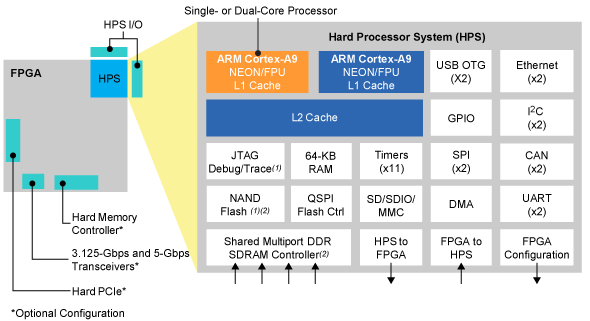
As mentioned in the previous part, for Intel's SoC, the FPGA project development environment is Quartus Prime, and the software development environment is DS-5 Altera Edition. It allows (in the free version) to develop applications for Linux, the development of Bare Metal applications that work without an operating system requires a commercial version of DS-5. Both Quartus Prime and DS-5 exist on both Windows and Linux versions.

So, let's review the boards themselves. I will not give here the entire catalog of Terasic motherboards, having limited myself to only a few motherboards, which I chose according to my own subjective criteria.
A great convenience is that all Terasic cards have USB JTAG.
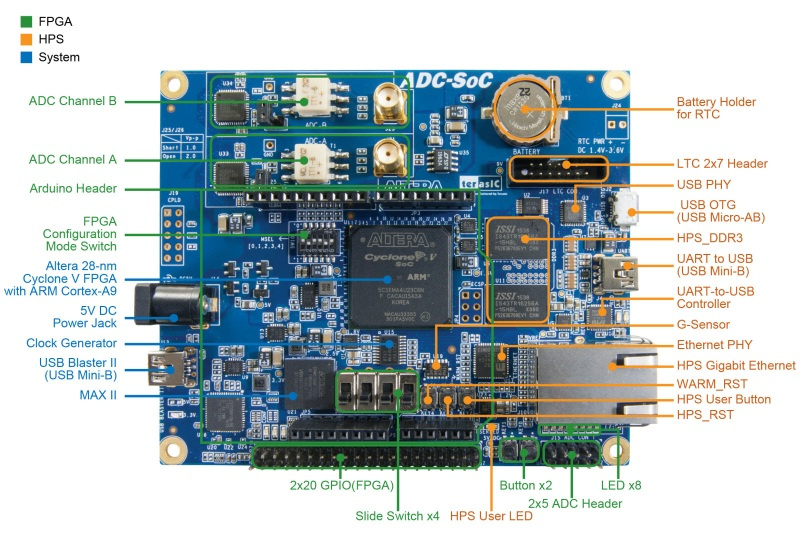
Manufacturer: Terasic
SoC: Cyclone V SE
RAM: 1 GB of DDR3 SDRAM
Flash: no
Ethernet: 10/100/1000
JTAG: there is
Arduino header: yes
Dimensions: 89x107 mm
Price: $ 550
Other features:
Two high-speed ADCs with high resolution, this is great if you want to make, for example, an SDR receiver. The disadvantage of the board is its price. Also, there is no flash-memory (download only from the SD-card).


SoC: 5CSXFC6D6F31C6N
RAM: 1GB DDR3 SDRAM (HPS), 64MB SDRAM (FPGA)
Flash: no
Ethernet: 10/100/1000 Ethernet
Size: 158x228 mm
Price: $ 660, academic price $ 559
Other features:
Devikit based on DE10-Standard board. Contains LCD 800x480 with a sensor for 5 simultaneous touches, an 8 megapixel camera, an illumination sensor, a 9-axis gyroscope / accelerometer / magnetometer. For more details, see the description of the DE10-Standard board (below).
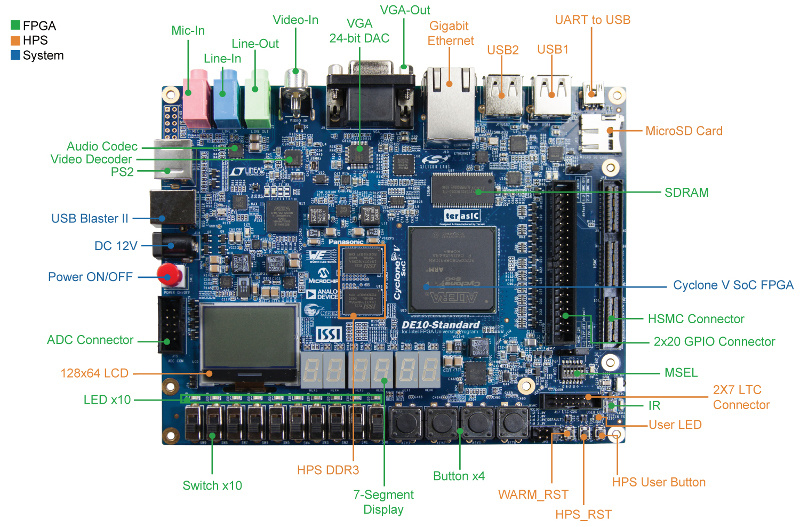
SoC: 5CSXFC6D6F31C6N
RAM: 1GB DDR3 SDRAM (HPS), 64MB SDRAM (FPGA)
Flash: no
Ethernet: 10/100/1000
Size: 166x130 mm
Price: $ 350 (academic price $ 259)
Other features:
Pretty typical devborda. Contains everything you need. There is a high-speed HSMC connector to which you can connect expansion cards, there is a regular IDC comb for low-speed signals. There is a video DAC (VGA), audio codec, a small screen 128x64 (monochrome), a G-sensor, an ADC of 12 bits x 8 channels. There are also LED indicators, buttons and a switch, as on most Terasic boards.
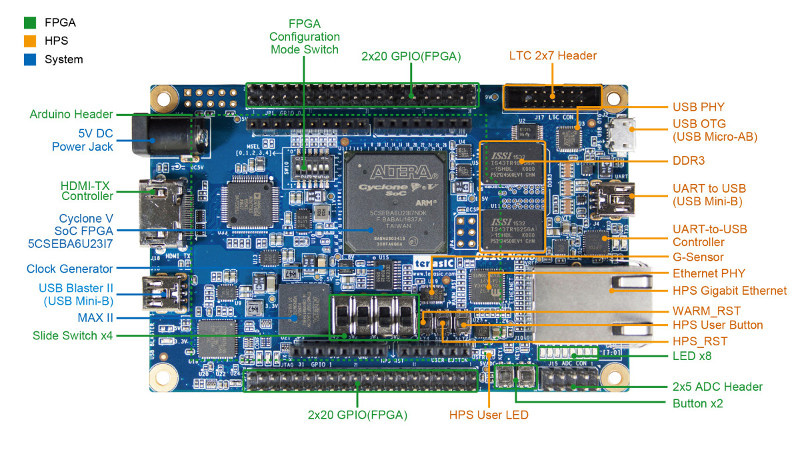
SoC: SE 5CSEBA6U23I7
RAM: 1GB DDR3 SDRAM
Flash: no
Ethernet: 10/100/1000
HDMI: yes
Arduino header: yes
Size: 69107 mm
Price: $ 130 (academic price $ 99)
Other features:
Minimalist and relatively affordable fee. A good option if you do not need a HSMC connector and all sorts of other excesses. However, the board is well equipped, and is certainly worth the price. There is an Arduino-compatible connector.
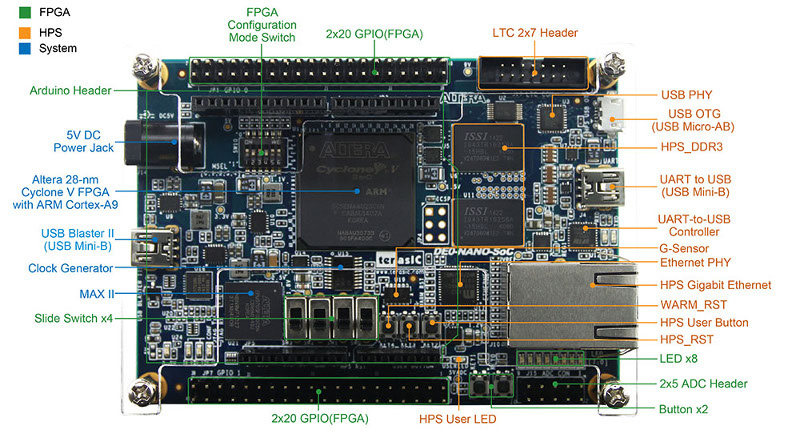
SoC: SE 5CSEMA4U23C6N
RAM: 1GB DDR3 SDRAM
Flash: no
Ethernet: 10/100/1000
HDMI: no
Size: 69x96 mm
Arduino hesder: yes
Price: $ 99 (academic price $ 90)
Other features:
Almost the same as the DE10-Nano Kit, with an even lower price. There is also an Arduino connector. The only difference is that this board does not have HDMI. A good option if you do not need surplus peripheral devices. Everything is minimalist and inexpensive compared to other boards.

SoC: 5CEBA4F23C7N
RAM: 64MB SDRAM
Flash: no
HDMI: no
Ethernet: no
Price: $ 150 (academic price $ 99)
Other features:
Unfortunately, the very small features of this board do not allow us to recommend it for purchase. Very little memory, and VGA with a “DAC” on the resistors, no Ethernet, this is too modest, even with a small price. It is better to buy DE10-Nano Kit, cheaper and better.
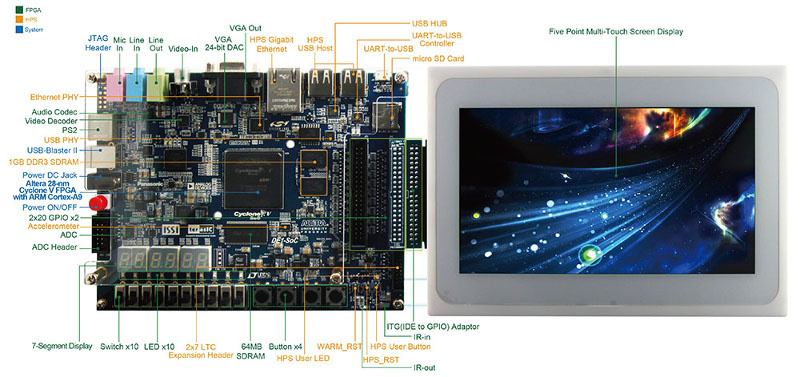
SoC: 5CSEMA5F31C6N
RAM: 1GB DDR3 SDRAM (HPS) + 64MB SDRAM (FPGA)
Flash: no
HDMI: no
Ethernet: 10/100/1000
Size: 354 x 130 mm
Price: $ 405 (academic price $ 330)
Other features:
A set consisting of an E1-SoC Board and a touch screen. See board specifications below.
It comes with a BSP (Board Support Package), which includes Linux, a touchscreen library and a pre-compiled Qt library.
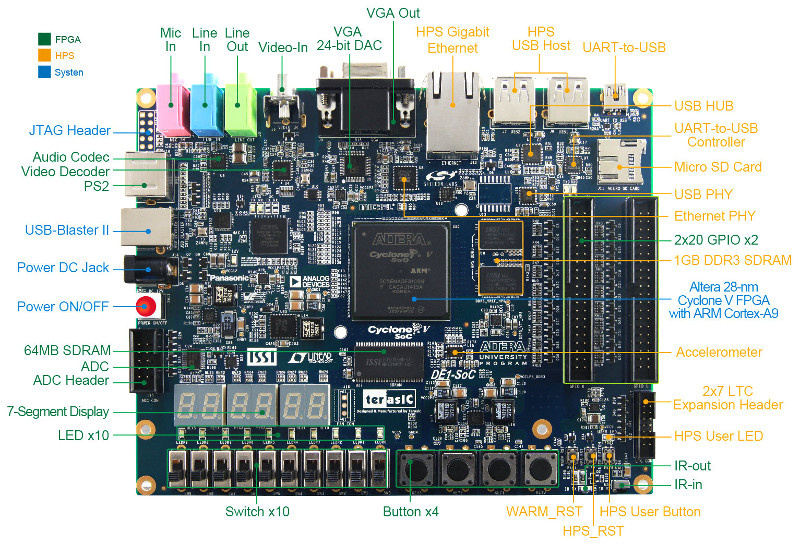
SoC: 5CSEMA5F31C6N
RAM: 1GB DDR3 SDRAM (HPS) + 64MB SDRAM (FPGA)
Flash: no
HDMI: no
Ethernet: 10/100/1000
Size: 354 x 130 mm
Price: $ 249 (academic price $ 175)
Other features:
Typical devborda, with good equipment. There is almost everything you might need, but nothing unusual.

SoC: 5CSXFC6D6F31C6N
RAM: 1GB DDR3 SDRAM (HPS), 1GB DDR3 SDRAM (FPGA)
Ethernet: 10/100/1000
Flash: 128 Mb QSPI
Size: 150 x 110 mm
Price: $ 350
Other features:
Excellent board, good equipment and compact size. Recommended for serious tasks.
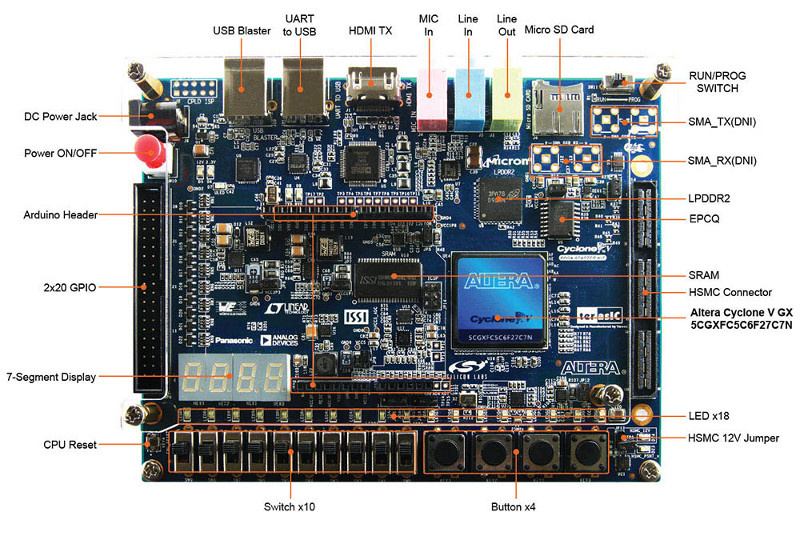
SoC: GX 5CGXFC5C6F27C7N
RAM: 4Gb LPDDR2 (HPS), 4Mb SRAM SDRAM (FPGA)
Ethernet: no
Flash: no
HDMI: yes
Arduino header: yes
Size: 150 x 116 mm
Price: $ 179
Other features:
Good opportunities for the price. The amount of RAM is the largest of all the boards in the review. This board, like SocKit, is a very good choice for serious tasks and educational purposes.
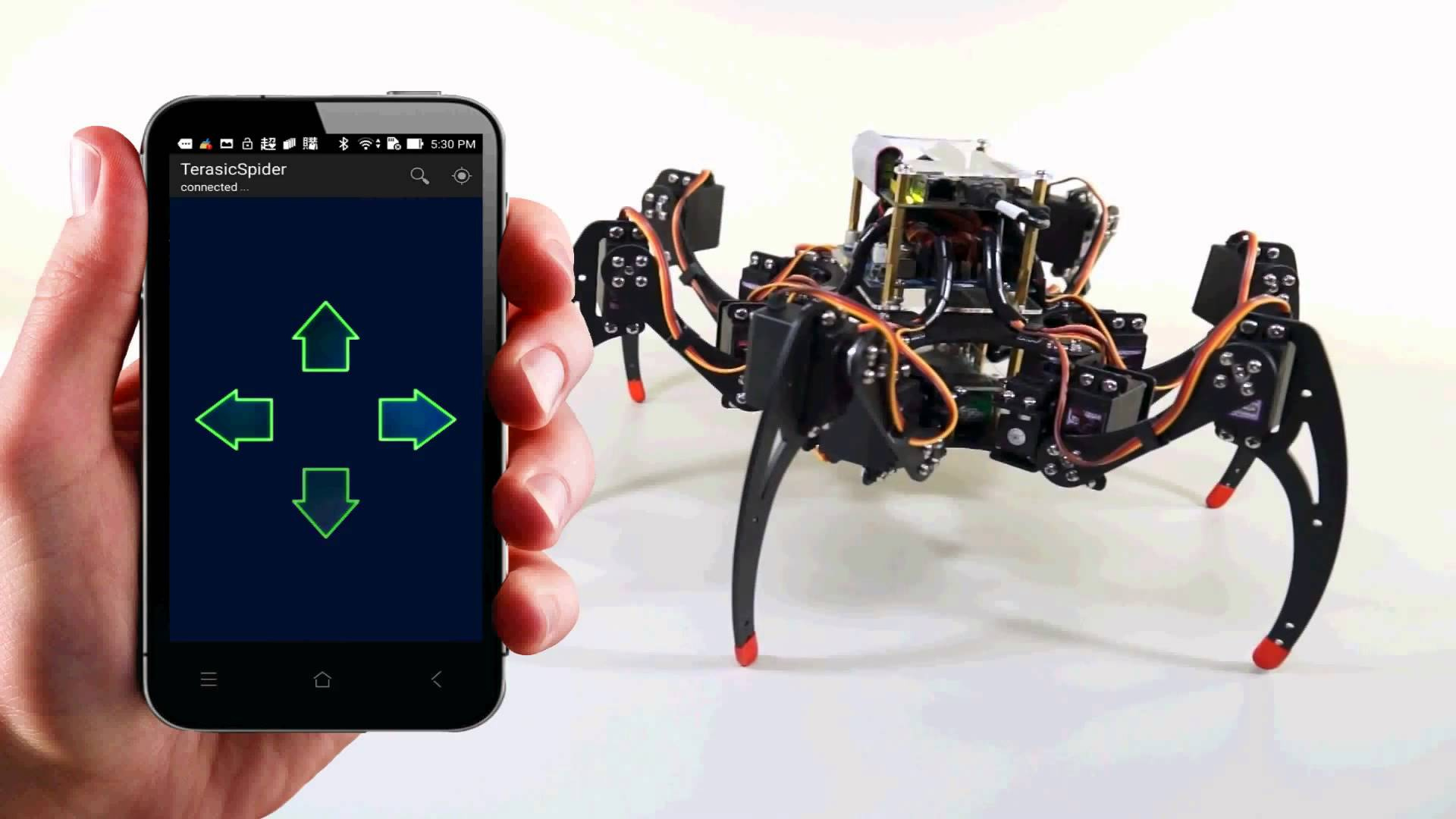
Robopauk based on the board DE0-Nano-SoC. Besides it, it contains a control board for servomotors and a chassis with 18 servomotors.
Price $ 1,200.
It seems to me expensive. If you want to get hold of such a toy, you can buy a DE0-Nano fee ($ 99) separately and make the chassis yourself by spending a significantly smaller amount.
So far, we have only considered Terasic boards, but there are other manufacturers of boards on Cyclone V. One of these manufacturers is EBV.
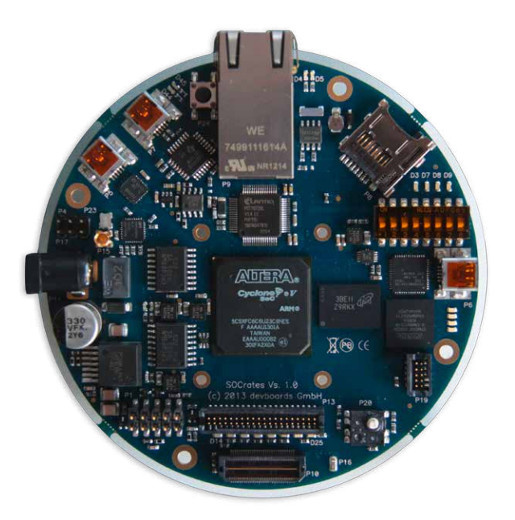
SoC: 5CSEBA6U23C7N
RAM: 128M DDR3
Flash: no
Ethernet: 10/100/1000
Size: 100 mm diameter
Price: 599 €
The board is an unusual round shape, quite old and rather expensive. More interesting is its next version, which is much more equipped with the same price (see below).
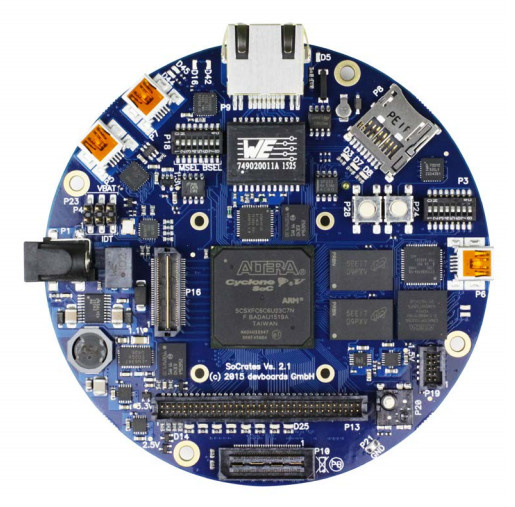
SoC: 5CSXFC6C6U23C7N
RAM: 1 GB DDR3
Flash: 256 Mbit FPGA Configuration Device (QSPI) + 256 Mbit HPS Boot Device (QSPI)
Size: 100 mm diameter
Price: 599 €
The second version of the round card from EBV. There is nothing unusual in it, and the price is rather big.
In conclusion, I will provide a list (far from complete) of useful resources that will help you master the wonderful world of SoC from Xilinx and Intel:
http://www.zynqbook.com/ - The Zynq Book and The Zynq Book Tutorials. Both books are available for download for free.
http://zedboard.org/content/microzed-chronicles - Adam Taylor's huge online Zynq tutorial, with examples of using various boards (MicroZed and more). The author is also one of the leading corporate blog XCell Daily Blog ( https://forums.xilinx.com/t5/Xcell-Daily-Blog/bg-p/Xcell ).
https://rocketboards.org/ is the central repository for documenting and source code, as well as a forum for Cyclone V. based boards.
Part 2. Intel World (Altera)
We continue the review of developer boards based on SoC with the ARM core. This time we will look at the SoC Cyclone V boards. This is not the only Intel SoC company, there is Arria V, Arria 10 and Stratix 10, but the price of boards based on them will not please you.
Unfortunately, Cyclone V-based boards are much smaller than on Xilinx Zynq, and they are mainly manufactured by one company, Terasic. There is also the Arrow SocKit board, but it is completely equivalent to the Terasic SoCKit board. The basic information on Terasic boards is focused on the rocketboards.org website. There you can download various useful materials, images of Linux distributions, there is also a forum. The forum is rather sluggish, and I would not count on getting support there, but something is better than nothing.
Terasic also sells some boards at a reduced price if you have a student card (“academic price”). I do not know how realistic this is for Russian students, but if someone has had the experience of such a purchase, it will be interesting to know. They write that, for example, when requesting a purchase at an academic price, Digilent refers to Russian distributors whose prices are 2-3 times too high. Maybe Terasic is acting differently.
In addition to Terasic products, we will also consider two boards produced by EBV. Other companies that produce products on Cyclone V, make mostly SoM modules, rather than devbordy, and did not get into the review.

Software
As mentioned in the previous part, for Intel's SoC, the FPGA project development environment is Quartus Prime, and the software development environment is DS-5 Altera Edition. It allows (in the free version) to develop applications for Linux, the development of Bare Metal applications that work without an operating system requires a commercial version of DS-5. Both Quartus Prime and DS-5 exist on both Windows and Linux versions.

Terasic
So, let's review the boards themselves. I will not give here the entire catalog of Terasic motherboards, having limited myself to only a few motherboards, which I chose according to my own subjective criteria.
A great convenience is that all Terasic cards have USB JTAG.
ADC-SoC

Board layout 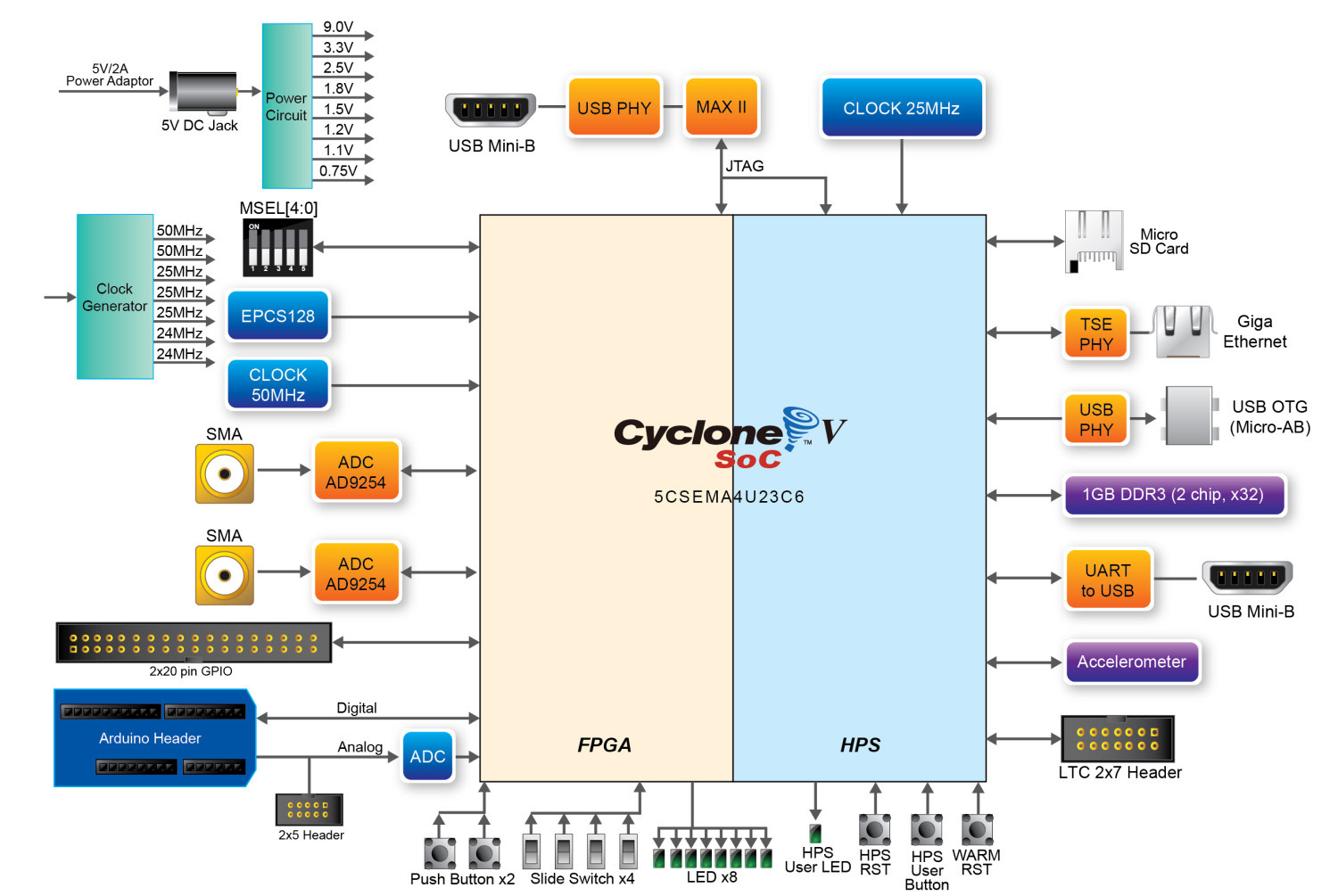

Manufacturer: Terasic
SoC: Cyclone V SE
RAM: 1 GB of DDR3 SDRAM
Flash: no
Ethernet: 10/100/1000
JTAG: there is
Arduino header: yes
Dimensions: 89x107 mm
Price: $ 550
Other features:
- 2 14 bit ADC, 150 MSPS
- G-sensor (accelerometer)
Two high-speed ADCs with high resolution, this is great if you want to make, for example, an SDR receiver. The disadvantage of the board is its price. Also, there is no flash-memory (download only from the SD-card).
VEEK-MT2S


Board layout 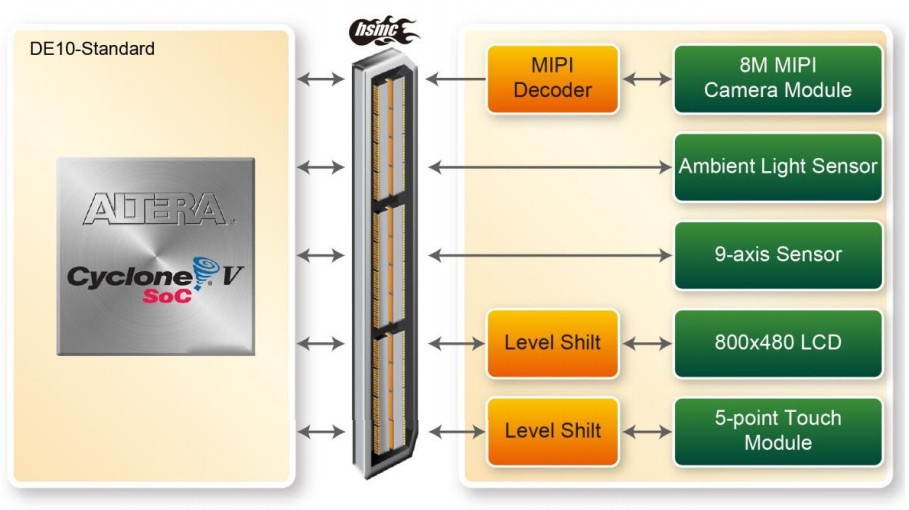

SoC: 5CSXFC6D6F31C6N
RAM: 1GB DDR3 SDRAM (HPS), 64MB SDRAM (FPGA)
Flash: no
Ethernet: 10/100/1000 Ethernet
Size: 158x228 mm
Price: $ 660, academic price $ 559
Other features:
- 24-bit VGA DAC
- 128x64 Dots LCD
- Audio 24-bit CODEC
- TV Decoder (NTSC / PAL / SECAM) and TV-In Connector
- ADC 500 KSPS x 12 bit x 8 channels
- G-sensor
Devikit based on DE10-Standard board. Contains LCD 800x480 with a sensor for 5 simultaneous touches, an 8 megapixel camera, an illumination sensor, a 9-axis gyroscope / accelerometer / magnetometer. For more details, see the description of the DE10-Standard board (below).
DE10-Standard

Board layout 

SoC: 5CSXFC6D6F31C6N
RAM: 1GB DDR3 SDRAM (HPS), 64MB SDRAM (FPGA)
Flash: no
Ethernet: 10/100/1000
Size: 166x130 mm
Price: $ 350 (academic price $ 259)
Other features:
- 24-bit VGA DAC
- 128x64 Dots LCD
- Audio 24-bit CODEC
- TV Decoder (NTSC / PAL / SECAM) and TV-In Connector
- ADC 500 KSPS x 12 bit x 8 channels
- G-sensor
Pretty typical devborda. Contains everything you need. There is a high-speed HSMC connector to which you can connect expansion cards, there is a regular IDC comb for low-speed signals. There is a video DAC (VGA), audio codec, a small screen 128x64 (monochrome), a G-sensor, an ADC of 12 bits x 8 channels. There are also LED indicators, buttons and a switch, as on most Terasic boards.
DE10-Nano Kit

Board layout 

SoC: SE 5CSEBA6U23I7
RAM: 1GB DDR3 SDRAM
Flash: no
Ethernet: 10/100/1000
HDMI: yes
Arduino header: yes
Size: 69107 mm
Price: $ 130 (academic price $ 99)
Other features:
- ADC
- G-sensor (accelerometer)
Minimalist and relatively affordable fee. A good option if you do not need a HSMC connector and all sorts of other excesses. However, the board is well equipped, and is certainly worth the price. There is an Arduino-compatible connector.
DE0-Nano-SoC Kit / Atlas-SoC Kit

Board layout 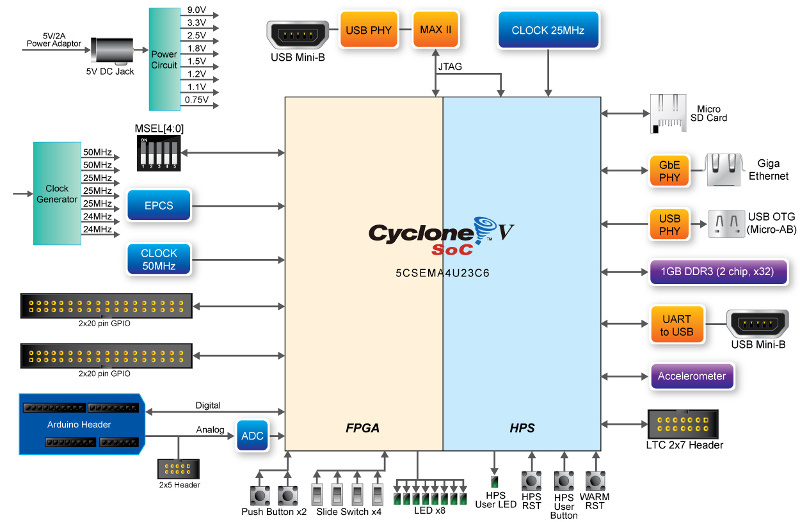

SoC: SE 5CSEMA4U23C6N
RAM: 1GB DDR3 SDRAM
Flash: no
Ethernet: 10/100/1000
HDMI: no
Size: 69x96 mm
Arduino hesder: yes
Price: $ 99 (academic price $ 90)
Other features:
- ADC
- G-sensor (accelerometer)
Almost the same as the DE10-Nano Kit, with an even lower price. There is also an Arduino connector. The only difference is that this board does not have HDMI. A good option if you do not need surplus peripheral devices. Everything is minimalist and inexpensive compared to other boards.
DE0-CV Board

Board layout 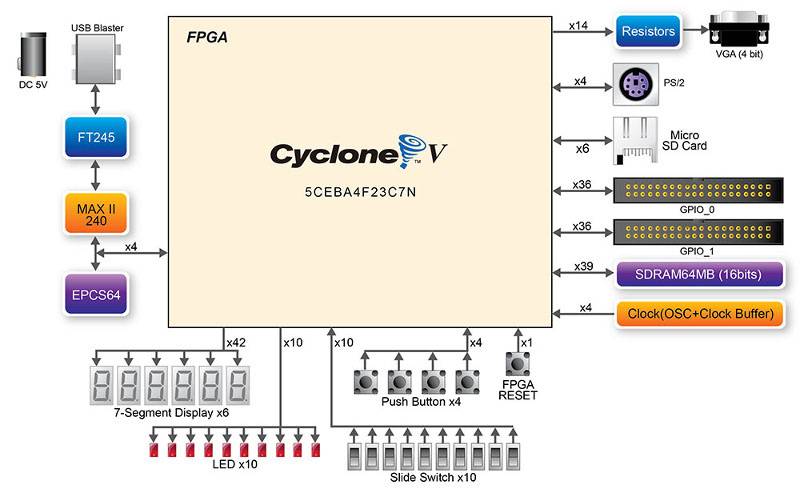

SoC: 5CEBA4F23C7N
RAM: 64MB SDRAM
Flash: no
HDMI: no
Ethernet: no
Price: $ 150 (academic price $ 99)
Other features:
- VGA (4 bit)
Unfortunately, the very small features of this board do not allow us to recommend it for purchase. Very little memory, and VGA with a “DAC” on the resistors, no Ethernet, this is too modest, even with a small price. It is better to buy DE10-Nano Kit, cheaper and better.
DE1-SoC-MTL2

Block diagram of the touch screen 
Block diagram of the touch screen. The block circuit diagram is described in the description of the DE1-SoC.

Block diagram of the touch screen. The block circuit diagram is described in the description of the DE1-SoC.
SoC: 5CSEMA5F31C6N
RAM: 1GB DDR3 SDRAM (HPS) + 64MB SDRAM (FPGA)
Flash: no
HDMI: no
Ethernet: 10/100/1000
Size: 354 x 130 mm
Price: $ 405 (academic price $ 330)
Other features:
- 24-bit VGA DAC
- Audio 24-bit CODEC
- TV decoder (NTSC / PAL / SECAM)
- ADC 500 KSPS x 12 bits x 8 channels
A set consisting of an E1-SoC Board and a touch screen. See board specifications below.
It comes with a BSP (Board Support Package), which includes Linux, a touchscreen library and a pre-compiled Qt library.
DE1-SoC Board

Board layout 

SoC: 5CSEMA5F31C6N
RAM: 1GB DDR3 SDRAM (HPS) + 64MB SDRAM (FPGA)
Flash: no
HDMI: no
Ethernet: 10/100/1000
Size: 354 x 130 mm
Price: $ 249 (academic price $ 175)
Other features:
- 24-bit VGA DAC
- Audio 24-bit CODEC
- TV decoder (NTSC / PAL / SECAM)
- ADC 500 KSPS x 12 bits x 8 channels
Typical devborda, with good equipment. There is almost everything you might need, but nothing unusual.
SoCKit

Board layout 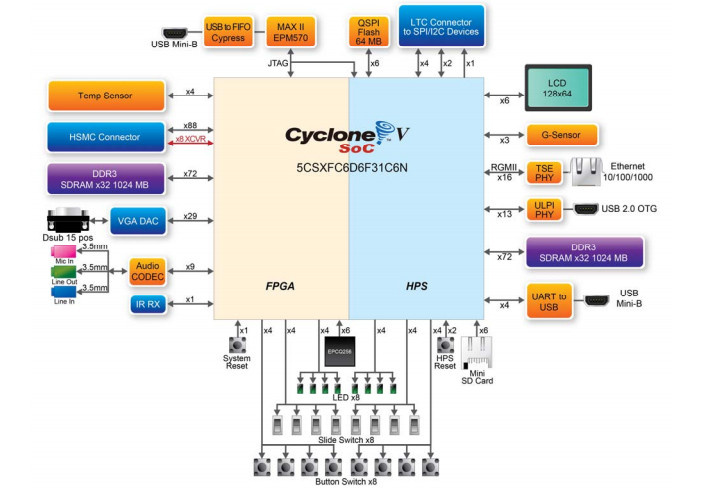

SoC: 5CSXFC6D6F31C6N
RAM: 1GB DDR3 SDRAM (HPS), 1GB DDR3 SDRAM (FPGA)
Ethernet: 10/100/1000
Flash: 128 Mb QSPI
Size: 150 x 110 mm
Price: $ 350
Other features:
- IR emitter / receiver
- 24-bit VGA DAC
- Audio 24-bit CODEC
- TV decoder (NTSC / PAL / SECAM)
- ADC 500 KSPS x 12 bits x 8 channels
- G-sensor (accelerometer)
- LCD 128 x 64
Excellent board, good equipment and compact size. Recommended for serious tasks.
Cyclone V GX Starter Kit

Board layout 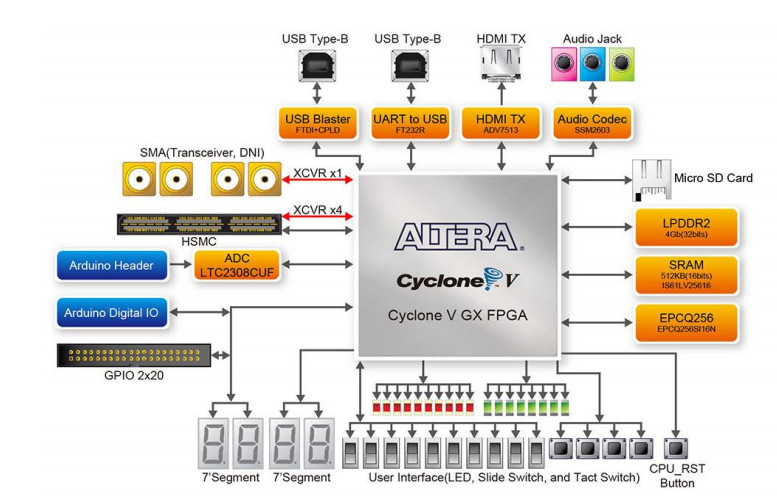

SoC: GX 5CGXFC5C6F27C7N
RAM: 4Gb LPDDR2 (HPS), 4Mb SRAM SDRAM (FPGA)
Ethernet: no
Flash: no
HDMI: yes
Arduino header: yes
Size: 150 x 116 mm
Price: $ 179
Other features:
- Audio 24-bit CODEC
- ADC 500 KSPS x 12 bits x 8 channels
- G-sensor (accelerometer)
Good opportunities for the price. The amount of RAM is the largest of all the boards in the review. This board, like SocKit, is a very good choice for serious tasks and educational purposes.
Terasic spider

Structural scheme 

Robopauk based on the board DE0-Nano-SoC. Besides it, it contains a control board for servomotors and a chassis with 18 servomotors.
Price $ 1,200.
It seems to me expensive. If you want to get hold of such a toy, you can buy a DE0-Nano fee ($ 99) separately and make the chassis yourself by spending a significantly smaller amount.
EBV
So far, we have only considered Terasic boards, but there are other manufacturers of boards on Cyclone V. One of these manufacturers is EBV.
SoCrates

Board layout 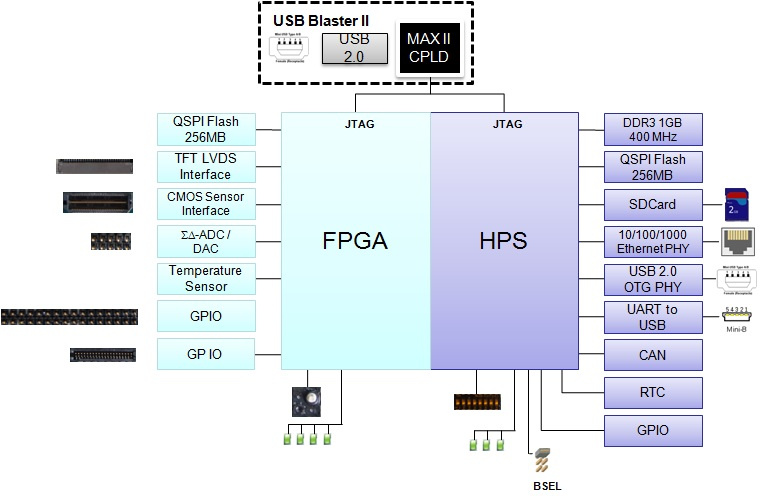

SoC: 5CSEBA6U23C7N
RAM: 128M DDR3
Flash: no
Ethernet: 10/100/1000
Size: 100 mm diameter
Price: 599 €
The board is an unusual round shape, quite old and rather expensive. More interesting is its next version, which is much more equipped with the same price (see below).
SoCrates II

Board layout 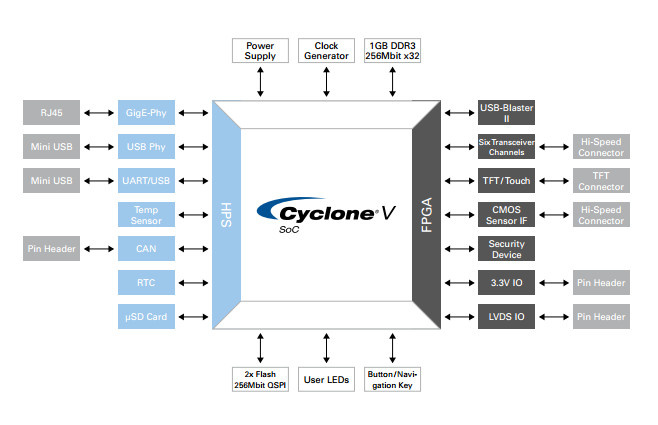

SoC: 5CSXFC6C6U23C7N
RAM: 1 GB DDR3
Flash: 256 Mbit FPGA Configuration Device (QSPI) + 256 Mbit HPS Boot Device (QSPI)
Size: 100 mm diameter
Price: 599 €
The second version of the round card from EBV. There is nothing unusual in it, and the price is rather big.
Useful resources
In conclusion, I will provide a list (far from complete) of useful resources that will help you master the wonderful world of SoC from Xilinx and Intel:
Xilinx
http://www.zynqbook.com/ - The Zynq Book and The Zynq Book Tutorials. Both books are available for download for free.
http://zedboard.org/content/microzed-chronicles - Adam Taylor's huge online Zynq tutorial, with examples of using various boards (MicroZed and more). The author is also one of the leading corporate blog XCell Daily Blog ( https://forums.xilinx.com/t5/Xcell-Daily-Blog/bg-p/Xcell ).
Intel (Altera)
https://rocketboards.org/ is the central repository for documenting and source code, as well as a forum for Cyclone V. based boards.
All Articles